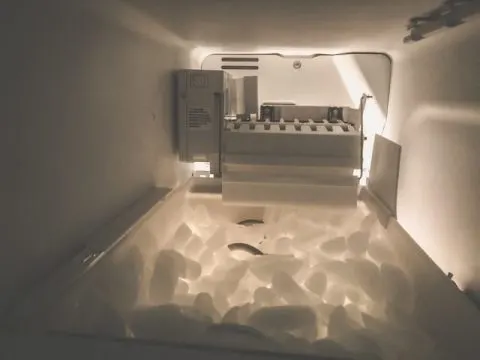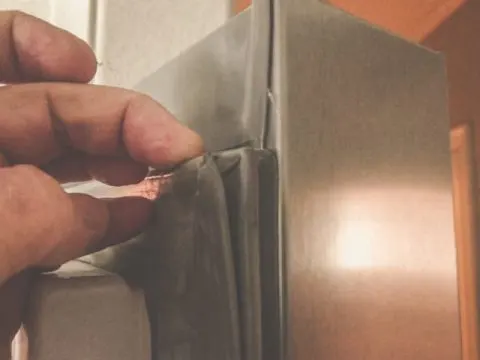Finding a puddle of water at the bottom of your refrigerator or on the floor is unexpected and alarming. You obviously want to know why that happened and what you can do about it.
The most common causes of a refrigerator drain pull being full of water include:
- A clogged drain system
- Malfunctioning ice maker
- The refrigerator is too level
- Worn-out door gasket
- Cracked drain pan
Before checking whether the drain or drain tube is clogged, there are some simple things to check that won’t require you to pull the fridge away from the door.
Since it always helps to understand why something could go wrong, let’s first look at how a refrigerator works and then take you through each step.
How Does a Refrigerator Work?
Understanding how a fridge works can help with the troubleshooting process. A refrigerator works on the principle that when a liquid evaporates, it also absorbs heat.
If you want to get rid of heat, you need to get the water to evaporate. Refrigerators force the coolant contained in the fridge’s coiled pipes to change from liquid to gas, thereby creating cold air (source).
Since the coolant stays in the pipes, how does water get into a refrigerator?
Condensation.
As temperature changes occur in a refrigerator, whether from being opened frequently, the addition of warm or hot foods, or the compressor in the back of the refrigerator having to work harder, water condenses.
Most of this condensation happens along the back of the fridge because that is where the evaporator that pulls warm air is located.
If you see some drops on the back of the fridge, no need to worry. If water has accumulated, then it’s time to troubleshoot. So let’s get started.
Pro Tip: It’s best to wait until heat food cools down before putting it into your fridge. Otherwise, not only will your machine have to work harder, but you increase the amount of moisture in the unit.
Check Your Icemaker for Damage

Before you go through the trouble of pulling the refrigerator from the wall, eliminate what you can access from the front, so check your icemaker first.
It is essential to understand how an ice maker works so that you know what to look for.
How an Icemaker Works
Most icemakers have three electrical components—motor, water valve, and heater. Water is fed into the icemaker via an intake tube that typically runs along the back of the fridge.
To make the cubes, an electrical signal sends a signal to open the water valve. A timer stops the water flow after 6 or 7 seconds, and the water begins to freeze.
A small thermostat monitors the temperature of the water, and when the ice has frozen, the heating coil warms the bottom of the trays to loosen the ice.
What to Look for When Investigating the Icemaker
One of the things that could be wrong is that the supply of water from the tube to the valve is loose. Check where the valve and tube meet and look for a leak. Sometimes all you need to do is tighten the
If you have a door dispenser and the leak is at the front of the unit, there is a problem with the door’s water line. If that is the case, fixing the tube is a complicated job. Consider calling an appliance repair technician.
If the tube looks good, then search for the fill cup. Sometimes water can leak out of the cup if it has been knocked loose or the refrigerator’s level is off.
Make Sure Your Refrigerator Is Correctly Unlevel
Some people think that a refrigerator is supposed to be level, but it isn’t. The front needs to be a ¼ to ½ inch higher than the back. This is required to allow the coolant to flow correctly.
If the coolant won’t flow properly, it causes the machine to work harder. This additional heat will increase the condensation inside the refrigerator, and that increased condensation leads to water on the floor.
The fix is to get a level. Place it on the floor or the top of your refrigerator, not a shelf, because the shelf itself may be crooked. Now check the level. If the front is not slightly higher than the back, you need to adjust the height of the front legs.
In most models, you will need to remove a grill in the front to raise the fridge. See your owner’s manual for directions on how to raise the front. Typically you will need a wrench or screwdriver for this task. Have a helper around if the fridge needs to be tilted back.
Examine Your Door Gasket

Hopefully, your refrigerator was not completely level, and this simple fix took care of the problem. While you are at the front of the fridge, check the gaskets are loose or worn.
If warm air is leaking into your refrigerator, the additional condensation can lead to leaks.
You can clean the gaskets and then apply a thin coating of petroleum jelly as a temporary solution. However, more likely than not, you are going to have to replace the gaskets.
Check the Defrost Drain
If your gaskets are in good shape, it’s time to check the drain inside your fridge. Again, the location of the drain could be under the vegetable pans or in the back.
A drain sometimes gets clogged with ice, which can be easily cleaned out with warm water. It might be clogged with dirt or food, so then you need to clean out the dirt and wash out the drain.
Check to See if Your Drain Pan Is Cracked or Overflowing
Sometimes, the solution can be as simple as a drain pan that has not been correctly put into place. In some models, the drain pan is accessible from the front.
If the pan is in the back, you will need to pull your refrigerator out unless it’s already out because of the defrost drain location.
If it’s full, empty it. Recheck it in a few days. If the pan is overflowing again, your refrigerator might have a problem with the compressor.
The drain pan can also be cracked. If that’s the case, you will need a replacement.
Check the Defrost Drain Tube
If none of those have solved the problem, then the actual drain tube is most likely clogged. Access to the drain tube is typically from the back of the machine.
If you notice a crack in the drain tube, then it will need to be replaced. Once again, the drain tube’s actual location varies, but on most refrigerators, it will be in the back.
- Find the drain tubes, which will usually be in the back of the unit.
- Flush hot water into the tube. A turkey baster is an excellent tool for this. Look for the water to end up in the drain pan.
- If it is still clogged, you’ll have to try and push out the dirt.
- After you have unclogged it, pour a soapy water and ammonia solution into the drainpipe to kill bacteria.
- Fit the drainpipe in place again. If you see water under the fridge, make sure you put it on tightly.
Bottom Line
Hopefully, the troubleshooting steps will clear up problems you have with water in your drain or on the floor under your fridge.
Some moisture will condense in your refrigerator, and if everything is working as it should, the water will evaporate. When it doesn’t, then you need to isolate the problem.
Luckily, many of these fixes are straightforward enough that you can do them and save yourself some money.
Related Reading:
Refrigerator Keeps Tripping Breaker: Troubleshooting Guide
As a homeowner, I am constantly experimenting with making the structure of my house more energy-efficient, eliminating pests, and taking on DIY home improvement projects. Over the past two decades, my family has rehabbed houses and contracted new home builds and I’ve learned a lot along the way. I share my hard-learned lessons so that you can save time and money by not repeating my mistakes.


Leave a comment
You must be logged in to post a comment.